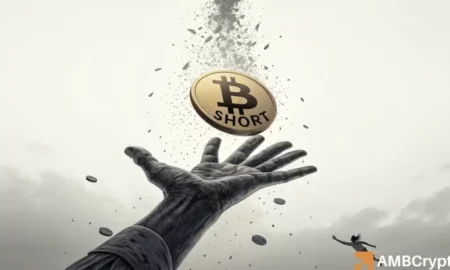Understanding the Impact of a Major Bitcoin Whale’s Short Position
In a recent high-stakes maneuver within the cryptocurrency arena, a substantial Bitcoin whale has taken a bold position by shorting $420 million worth of BTC. Utilizing $80 million in USDC on the trading platform Hyperliquid, this trader leveraged the investment by over five times, raising eyebrows across the crypto community. This significant move has raised questions about its implications for Bitcoin’s short-term trajectory and whether it signals a major market downturn.
Whale’s Strategic Move
The whale’s decision to short Bitcoin comes at a critical time. Bitcoin’s price was hovering around $121,000, having experienced weeks of volatility and positive ETF inflows. Coupled with a $50 million transfer to Binance for an additional short position, this strategy marks a high-level gamble against the market. The primary concern is whether these actions foreshadow a significant downturn in Bitcoin’s price. However, on-chain data from Arkham Intelligence shows that despite this aggressive short, the immediate market reaction indicates a cautious optimism among traders.
Market Sentiment: Mixed Signals
While the whale’s large short position could suggest a bearish stance, market data tells a different story. Analysis by Coinglass reveals that Bitcoin’s open interest-weighted funding rate stood at 0.0043% as of October 9, indicating that bullish sentiment still prevails among traders. In the previous 24 hours, the market noted total long liquidations worth $121 million, significantly higher than $63 million in shorts. This data suggests that while some traders are liquidating their long positions, the overall sentiment remains cautiously positive, keeping the market balanced.
Institutional Demand Counterbalances Bearish Bets
Despite the bearish potential implied by the whale’s move, institutional demand for Bitcoin remains robust. Recent figures from SosoValue indicate that Bitcoin Spot ETFs have witnessed inflows for eight consecutive days, steadily fostering a sense of market confidence. These inflows can help cushion any impending volatility that may arise from large short positions. Current metrics suggest that traders are interpreting the whale’s actions more as a tactical play rather than an outright signal of impending doom for Bitcoin.
Price Dynamics and Future Outlook
Assessing the current price dynamics, Bitcoin is struggling to maintain its footing above the pivotal $121,000 mark. After facing multiple rejections around $123,000, it experienced a slight decline of 1.9%, signaling a potential shift in momentum. The Relative Strength Index (RSI) rests at approximately 58, suggesting that while momentum is cooling, it has not reached oversold levels. Although there are signs of price exhaustion, the overall trend remains intact, with immediate support levels identified at $118,000 and a critical demand zone around $112,000.
Analyzing Market Structure and Short-Term Volatility
Despite the whale’s aggressive short strategy, Bitcoin’s price structure appears to be holding firm. However, the increased selling pressure may lead to short-term volatility, especially if the whale’s position triggers broader fear among traders. Maintaining a price above $123,500 is crucial for Bitcoin to initiate a renewed push toward higher targets of $126,000 to $128,000. In summary, the market shows resilience amid mixed signals—prompting traders to remain vigilant about potential shifts in sentiment as they navigate this complex landscape.
In conclusion, the movement of a Bitcoin whale has undoubtedly stirred discussion within the cryptocurrency space. While the short position may suggest uncertainty, the prevailing market sentiment, bolstered by institutional interest, indicates that traders should exercise caution before interpreting this as a clear signal of a major downturn. As the market evolves, ongoing analysis will be vital to understanding the intricate dynamics at play.
















